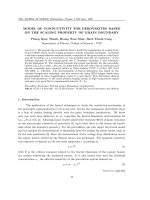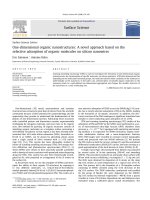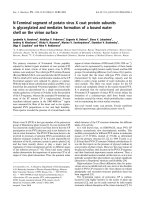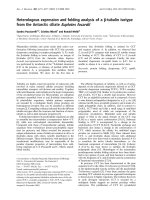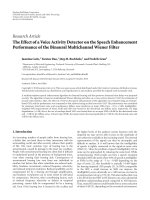Reliability analysis of a power system based on the multi state system theory
Bạn đang xem bản rút gọn của tài liệu. Xem và tải ngay bản đầy đủ của tài liệu tại đây (1004.18 KB, 4 trang )
Reliability Analysis of a Power System Based on the
Multi-State System Theory
Chunyang LI
College of Mechatronics Engineering and Automation
National University of Defense Technology
Changsha, 410073, China
E-mail:
Xun CHEN, Xiaoshan YI
College of Mechatronics Engineering and Automation
National University of Defense Technology
Changsha, 410073, China
Abstract—Reliability analysis of power systems using the
traditional system reliability theory usually can not represent the
real-life situation. The multi-state system theory is introduced to
analyze the reliability of a power system. States and
corresponding probabilities of the battery are defined. The
reliability of the power system is estimated by the multi-state
system theory. The results show that the system reliability
estimated by the traditional system reliability theory is
conservative, and the proposed method in this paper is better to
analyze the reliability of power systems.
Keywords- power system; multi-state system theory; reliability;
universal ge
nerating function
I. I
NTRODUCTION
A power system composed of battery pack provides en
ergy
for other systems, and the reliability of this power system is
very important. To analyze the reliability of the power system
using the traditional system reliability theory, the reliability of
the battery should be gained first, and then the system
reliability can be computed according to the structure of the
system [1]. This method is simple, but it can not be applied to
power systems with required capacities. The power system will
fail when the system capacity is less than the required capacity
even though the batteries of the system are all working.
The traditional system reliability theory defines the power
system and the batteries are b
inary, but they are all multi-state
actually. The performance of the batteries can degrade, which
results in performance degradation of the power system. So
there can be several states of degradation. Compared with
binary system, the multi-state system can perform its task with
many different performance levels except failed and working
[2, 3]. The research on multi-state systems began in the 1970s
[4, 5], and gained a lot of researchers’ attention. Many papers
have been devoted to estimating the reliability of the multi-
state system [6-8] and optimizing the structure of the multi-
state system [9-11].
The reliability of the power system will be
analyzed by the
multi-state system theory in this paper. The procedure of
applying the multi-state system theory to the reliability analysis
of the power system is studied. The relationship between the
performance of the system and the performance of the batteries
is analyzed. The results obtained by the traditional system
reliability theory are compared with the results obtained by the
multi-state system theory.
II. P
ROBLEM
F
ORMATION
The power system is composed of eight identical batteries.
A branch c
onsists of two batteries connected in series, and the
system consists of four branches connected in parallel as
depicted in Fig. 1. The required capacity of the power system is
not less than 22.8 Ah. To protect proprietary data, all
parameters have been scaled. This does not in any way affect
the validity of the method presented in this paper.
Figure 1. Structure of the power system
A test of 120 batteries shows that the capacities of the
batteries follow the s-normal distribution with mean 6000,
variance . In short, , where
G
is the
capacity of the battery.
2
150
()
2
~ 6000,150GN
To analyze the reliability of the system by the traditional
system reliability theory, we must gain the reliability of the
battery first. The power system has to provide the required
capacity, and the system will fail when the required capacity is
not fulfilled. According to the structure and the required
capacity of the system, the reliability of the battery is defined
as the probability that the capacity of the battery is not less than
5700 mAh. Then the reliability of the battery is:
{ }
Pr 5700 0.97725RG=≥ =
.
When the capacity of one battery is less
than 5700 mAh,
the required capacity of the power system may be not fulfilled.
So the reliability of the power system estimated by the
traditional system reliability theory is:
.
8
0.83185
st
RR==
978-1-4244-4905-7/09/$25.00©2009 IEEE
95
This method can solve the problem, but the result is
conservative. Because actually the reliability of the power
system is:
. (1)
{
Pr 22.8
ss
RG=≥
}
Equation (1) indicates that when the capacity of the system
is above 22.8 Ah, the system is reliable, though the capacity of
a battery is lower than 5700 mAh. Suppose the capacity of the
first branch is 5600 mAh and the capacity of other branches are
all above 5800 mAh, the system is reliable because the
required capacity is reached. But when we analyze the system
reliability using the traditional system reliability theory, the
system fails. So this problem will be solve by another method
— the multi-state system theory.
III. M
ULTI
-
STATE
S
YSTEM
T
HEORY
Assume that the component has
M
possible states, and the
performance is
{ }
12
,,,
M
g gg=g "
, with the corresponding
probability is
{ }
12
,,,
M
qq q=q "
, where
{ }
Pr
ll
qG
,
is the performance of the component, . Then the
universal generating function of the component is:
g==
G
M1, ,l= "
()
1
l
M
g
jl
l
Uz qz
=
=⋅
∑
. (2)
To obtain the universal generating function of the system,
the operat
ors of the universal generating function are defined as
follows [2, 3]:
(3)
() ()
()
()
,
12
11
,
kl
MM
fg g
kl
kl
UzUz qqz
==
Ω=⋅⋅
∑∑
,
() () ( )()
()
() () () ()
()
11
11
,, , ,,
,, , ,,
kk n
kk n
Uz U zU z U z
Uz U zU z U z
+
+
Ω
=Ω ,
""
""
(4)
. (5)
() () () ()
(
() ()
()
() ()
()
11
11
,, , ,,
,, , ,,
kk n
kk n
Uz U zU z U z
Uz U z U z U z
+
+
Ω
⎡
=Ω Ω Ω .
⎣
""
""
)
⎤
⎦
The
( )
,
kl
f gg
is defined according to the structure of the
multi-state system.
When the performance of the system is eq
ual to the sum of
the performance of components, define the
π
operator:
() ()
()
12
11
,
kl
MM
g g
kl
kl
UzU z qqz
π
+
==
=⋅⋅
∑∑
. (6)
When the performance of the system is equal to the
minim
um of the performance of components, define the
σ
operator:
() ()
()
min( , )
12
11
,
kl
MM
g g
kl
kl
UzUz qqz
σ
==
=⋅⋅
∑∑
. (7)
Of course, other operators can also be defined according to
the situatio
ns.
The universal generating function for the system can be
obtained usi
ng simple algebraic operations over individual
universal generating function of components:
, (8)
() () ()
()
1
1
,,
i
m
M
G
in
m
Uz Uz U z qz
σ
=
==
∑
"
m
() () ()
()
1
1
,,
sys
s
M
G
N
s
Uz U z U z qz
π
=
==
∑
"
s
, (9)
where
( )
i
Uz
is the universal generating function of subsystem
; is the number of components in subsystem
i
;
i
n
i
M
is the
number of possible states of subsystem
i
. is the
performance of subsystem
i
; is the corresponding
probability;
m
G
m
q
( )
Uz
is the universal generating function of the
system; is the number of subsystems in the system;
N
sys
M
is
the number of possible states of the system;
s
G
is the
performance of the system;
s
q
is the corresponding probability.
Define the following
δ
operator over
( )
Uz
:
, (10)
()
()
(
11
,,
sys sys
ss
MM
GG
ss
ss
Uz W qz W qz W
δδ δ
==
⎛⎞
==
⎜⎟
⎜⎟
⎝⎠
∑∑
)
,
,
(11)
()
,
,
0, ,
s
ss
G
s
s
qGW
qz W
GW
δ
≥
⎧
=
⎨
<
⎩
where
W
is the required performance level of the system.
Then the reliability of the system is:
( ) { }()
()
Pr ,
s
sms
GW
RW G W UzW q
δ
≥
=≥= =
s
∑
. (12)
IV.
S
TATES
D
EFINITION AND
P
ROBABILITIES
E
STIMATION
Suppose that the capacity of the battery is divide
d into
1
M
+
intervals:
[
)
1
0, w
, …,
[
)
1
,
MM
ww
−
,
[
)
,
M
w ∞
,
11
0
M M
ww
−
w< << <"
. The states of the battery can be
defined as follows:
state 0:
1
0 Gw≤ <
state 1:
12
wGw≤ <
…
state
1
M
−
:
1M M
wGw
−
≤ <
state
M
:
M
Gw≥
M
can be determined by the analytical precision. In this
paper, the capacity of the battery is divided into eight intervals,
that is:
[
)
5200,5550
,
[
)
5550,5700
, ,
[
)
5700,5850
[
)
5850,6000
,
[
)
6000,6150
,
[
)
6150,6300
,
[
,
)
6300,6450
[
)
6450,6800
.
96
To obtain the lower bound of the system reliability, the
performance of each state is defined as the minimum capacity
of each interval, that is:
1
5200g =
, , , ,
2
5550g =
3
5700g =
4
5850g =
5
6000g =
, , , .
6
6150g =
7
6300g =
8
6450g =
State probability is defined as
{ }
Pr
l
qGg==
l
, and then
the corresponding state probabilities of the battery are:
{}
{}
1
8
Pr 5200 5550
Pr 6450 6800 0.00135 ,
qG
qG
=≤<
== ≤< =
{}
{}
2
7
Pr 5550 5700
Pr 6300 6450 0.02140 ,
qG
qG
=≤<
== ≤< =
{}
{}
3
6
Pr 5700 5850
Pr 6150 6300 0.13591,
qG
qG
=≤<
== ≤< =
{}
{}
4
5
Pr 5850 6000
Pr 6000 6150 0.34134 .
qG
qG
=≤<
== ≤< =
Because
{ } { }
8
Pr 5200 Pr 6800 4.82130 10GG
−
<=≥= ×
,
the intervals
[
and
)
0,5200
[
)
6800,∞
are not considered.
Then we can get the state performance of the battery is
,
{
5200,5550,5700,5850,6000,6150,6300,6450=g
}
and the corresponding probability is
{0.00135,0.02140,0.13591,0.34134,
0.34134,0.13591,0.02140,0.00135}.
=
q
V.
R
ELIABILITY
A
NALYSIS OF THE
P
OWER
S
YSTEM
The reliability of the power system is analyzed using the
mult
i-state system theory. According to (2), the universal
generating fun
ction of the battery is:
( )
5200 5550 5700 5850
6000 6150 6300 6450
0.00135 0.02140 0.13591 0.34134
0.34134 0.13591 0.02140 0.00135 .
j
Uzzzzz
zzz
=+++
z
+ +++
Based on the operators defined in (7) and (8), the universal
generating fun
ction of the branches can be obtained, and then
the universal generating function of the power system can be
computed by
(6) and (9). According to (12), the reliability of
the power system is
:
{ }
Pr 22.8 0.98682
sm s
RG=≥=
.
The results show that when the required capacity of the
power sy
stem is 22.8 Ah, the result gained by the multi-state
system theory is larger than the result gained by the traditional
system reliability theory. Fig. 2 is the reliability obtained by
these two methods in different capacities.
From Fig. 2 we know that the results obtained by the
traditional syste
m reliability theory are always conservative.
For example, when the required capacity is 23.4 Ah, the
reliability of the system obtained by the traditional system
reliability theory is only 0.25107, but the reliability of the
system obtained by the multi-state system theory is 0.55963.
Figure 2. The results obtained by the two methods
VI.
C
ONCLUSIONS
The multi-state system theory is introduced to analyze the
reliability of the power system
in this paper, and is compared
with the traditional system reliability theory. The results show
that:
97
(1) The reliability of the power system obtained by the
traditional system reliability theory is always conservative.
(2) The power system is a multi-state system. The multi-
state sy
stem theory can define the relationship between
component performance and system performance, and the
reliability of the power system obtained by this method is much
better.
A
CKNOWLEDGMENT
The authors would like to thank the Graduate School of
National Univer
sity of Defense Technology for supporting this
research work.
R
EFERENCES
[1] X.F. Liu, J.Y. Zou, and L.W. Li, “Study on reliability of storage battery
array with high capacity,” Journal of Jilin University (Engineering and
Technology Edition), 2007, Vol.37, No.3, pp. 672–674.
[2] G. Levitin, The Universal Generating Function in Reliability Anal
ysis
and Optimization, London: Springer, 2005.
[3] A. Lisnianski, and G. Levitin,
Multi-state System Reliability:
Assessment, Optimization and Applications. Singapore: World
Scientific, 2003.
[4] R. M. Ba
rton, and W. W. Damon, “Reliability in a multi-state system,”
Proceedings Sixth Annual Southeastern Symposium on Systems Theory,
Louisiana, 1974.
[5] R. E. Barlow, and A. S. Wu, “Coherent syste
ms with multi-state
components,” Mathematics of Operations Research, 1978, Vol.3,
pp.275–281.
[6] K. Yu, I. Koren, Y. Guo. General
ized multistate monotone coherent
systems. IEEE Transactions on Reliability, 1994, Vol. 43, No.2, pp.242–
250.
[7] J. Huang, M. J. Zuo, and Y. Wu, “
Generalized multi-state k-out-of-n:G
systems,” IEEE Transactions on Reliability, 2000, Vol.49, pp.105–111.
[8] G. Levitin, “A universal generating function approach for the analysis of
m
ulti-state systems with dependent elements,” Reliability Engineering
and System Safety, 2004, Vol.84, No.3, pp.285–292.
[9] G. Levitin, Anatoly
Lisnianski, Hanoch Ben-haim, “Redundancy
optimization for series-parallel multi-state systems,” IEEE Transactions
on Reliability, 1998, Vol.47, No.2, pp.165–172.
[10] M. Ouzineb, M. Nourelfath, and M. Gendreau, “Tabu search for the
r
edundancy allocation problem of homogenous series-parallel multi-
state systems,” Reliability Engineering and System Safety, 2008, Vol.93,
No.8, pp.1257–1272.
[11] M. Agarwal, and R. Gupta, “Homogeneous r
edundancy optimization in
multi-state series-parallel systems: A heuristic approach,” IIE
Transactions, 2007, Vol.39, pp.277–289.
[12] Y. Liu, H.Z. Huang, “Comment on ‘‘A framework to practical predictive
m
aintenance modeling for multi-state systems’’ by Tan C.M. and
Raghavan N. [Reliab Eng Syst Saf 2008; 93(8): 1138–50],” Reliability
Engineering and System Safety, 2009, Vol.94, No.3, pp.776-780.
[13] Y. Liu, H
.
Z. Huang, “Reliability and performance assessment for fuzzy
multi-state elements,” Proceedings of the Institution of Mechanical
Engineers, Part O: Journal of Risk and Reliability, 2008, Vol. 222, No. 4,
pp.675-686.
98



